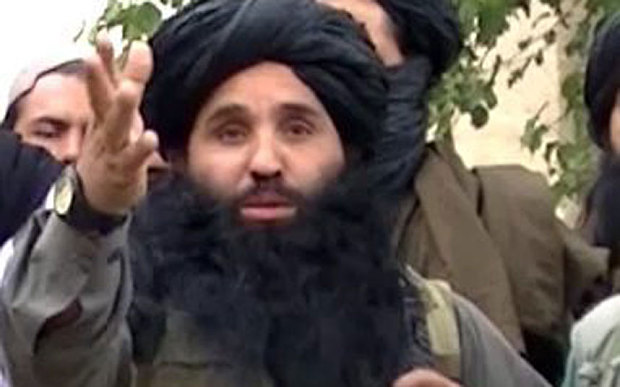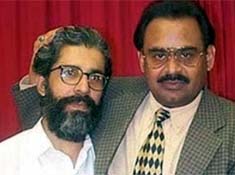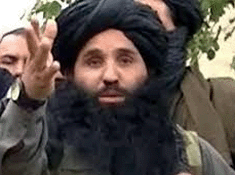Taliban leaders give sleepless nights to Pakistan’s security establishment

ISLAMABAD: (Asia Times): The failure of the ongoing military operation against Tehrik-e-Taliban Pakistan (TTP) and its allied terrorist groups can be linked to three of its most dangerous commanders Mullah Fazlullah, Omar Mansoor Naray and Umar Khalid Khurasani who are giving sleepless nights to the Pakistani security establishment.
Despite shifting their bases to Afghanistan in the aftermath of the North Waziristan military action Operation Zarb-e-Azab, these jihadi monsters have successfully masterminded dozens of dastardly terrorist attacks across Pakistan during the past two years. Like dozens of other jihadi kingpins, Fazlullah, Naray and Khurasani fled to Afghanistan, taking advantage of Pakistan’s 2,600 km porous border. Using the Afghan territory as a launching pad, they dispatched fidayeen attackers to every nook and corner of Pakistan to target troops and civilians to avenge Operation Zarb-e-Azab.
The Pakistani security establishment has become so frustrated by the terrorist activities that last week, Army Chief General Raheel Sharif called upon a high level delegation of senior American officials to use drone to eliminate Fazlullah. The Commander of Resolute Support Mission in Afghanistan, General John Nicholson, and US Special Representative for Afghanistan and Pakistan, Ambassador Richard Olson, met with Sharif in Islamabad on June 10. During the meeting, Sharif raised the demand of targeting Fazlullah alleging that he was being backed by some hostile intelligence agencies of neighboring countries to foment terrorism in Pakistan.
While the Afghan Taliban leader Mullah Mohammad Akhtar Mansour was killed by an American drone in Baluchistan recently, Fazlulla keeps dodging death. Pakistan’s most wanted terrorist, he tops the list of potential US targets after being tagged a “common enemy” of the United States and Pakistan last year. Currently operating from the Kunar province of eastern Afghanistan on the Pak-Afghan border, the Fazlullah-led militants are conducting cross border ambushes against the Pakistani security forces deployed on the border. In December 2015, Afghan President Dr Ashraf Ghani conceded during the Heart of Asia conference in Islamabad that Fazlullah was hiding in Afghanistan.
Peshawar school massacre
Fazlullah was designated a ‘Specially Designated Global Terrorist’ by the US State Department in January 2005 in the aftermath of the Army Public School massacre in Peshawar on December 16, 2014. Pakistani authorities sought help from Washington and Kabul after intercepting wireless and cell phone messages which established that Fazlullah himself directed the Peshawar school carnage which killed 133 innocent children. While mentioning his role in the school attack, the US State Department press release listed other attacks engineered by him.
“Prior to becoming the leader of the TTP, Fazlullah claimed that he was behind the killing of Pakistani Army Major General Sanaullah Niazi in September 2013, besides ordering the shooting of schoolgirl Malala Yousafzai in 2012. Mullah Fazlullah was responsible for beheading 17 Pakistani soldiers after an attack in June 2012 and also ordered the targeted killings of elders who led peace committees against the Taliban,” the release said.
Fazlullah killed several Pakistani soldiers and is also wanted for the deaths of three US soldiers in the Lower Dir District of the Khyber Pakhtunkhwa on February 3, 2010. He was appointed TTP leader on November 7, 2013 following the death of Hakeemullah Mehsud in a US drone attack in North Waziristan. Inspired by the late Afghan Taliban leader Mullah Mohammad Omar, he soon became known as Mullah Radio for the illegal FM radio stations he used to run in the Swat valley of Khyber Pakhtunkhwa to instigate people through his sermons for taking part in jihad.
The son-in-law of Maulana Sufi Mohammed, the founder of the Tehrik-e-Nifaz-e-Shariat-e-Mohammadi (Movement for Execution of Islamic Shariah), Fazlullah was driven out of the Swat Valley along with his private militia in October 2009 following a military operation. Over 3,000 Pakistani troops had been sent to Swat to confront the Taliban forces that were massing in the valley with a view to impose Shariah law. Over two dozen Pakistan Army soldiers were killed in Swat in suicide bombings carried out by Fazlullah’s fidayeen attackers.
Second most wanted man
Another most wanted Taliban leader currently operating from the Afghan soil is Fazlullah’s close aide, Commander Omar Mansoor Khalifa alias Omar Adenzai Naray who had not only masterminded the dastardly carnage at Peshawar’s Army Public School but also claimed the same in a video-taped message. The school was targeted because most students belonged to military families, according to TTP spokesman Mohammad Khorasani in his subsequent claim. He conceded that the school attack was masterminded by Omar Mansoor group and carried out by six fidayeen attackers.
A video posted on a Taliban website after the attack showed a man with a chest-length beard, who sought to justify the attack. The caption identified him as Omar Mansoor. Investigations into the Army school massacre revealed that the attackers were communicating with Mansoor across the border in Afghanistan while they were butchering students. Mansoor threatened more revenge attacks if the military and the intelligence agencies did not stop operations against Taliban militants. Director General ISPR Major General Asim Saleem Bajwa stated in a February 12, 2015 press briefing that the security forces made arrests in connection with the school attack and all those involved, except six, were killed or captured.
“The main planners and facilitators who are still at large include Mullah Fazlullah, Omar Mansoor, Asif Ali, Taj Mohammad and Qari Saifullah. Six of those already arrested by the agencies include Atiqur Rehman (a sub-operation commander), a government-employed cleric at a mosque Abdul Salam (facilitator), Kifayat (facilitator), Hazrat Ali (financier who also carried a head money of Rs2.5 million), Sabeel Afridi (involved in transporting the fidayeen attackers) and Mujibur Rehman (host of the attackers),” Bajwa said.
Omar Mansoor’s younger brother Mustafa alias Munoon and four of his accomplices were killed in a joint operation by the law-enforcement and intelligence agencies in the Frontier Region Peshawar in the aftermath of the Army Public School attack. Coming from the Adenzai sub division of Lower Dir district in Khyber Pakhtunkhwa, Mansoor was affiliated with Tariq Geedar Group (TGG) of the TTP which still operates from Darra Adam Khel in Khyber Pakhtunkhwa. The US State Department had declared the TGG as specially designated global terrorists on May 26, 2016.
Mansoor’s real name is Aurangzeb and he been using three different names — Omar Naray, Omar Adenzai and Omar Khalifa. Obviously, he prefers the last name as it confers on him some respectability in the ranks of the militants and makes him important in the hierarchy of the Pakistani Taliban. Omar Mansoor completed his high school education from Islamabad and then studied at a religious seminary in the federal capital. He has two brothers and he spent some time working in Karachi as a laborer before joining the TTP soon after its formation in December 2007 by Commander Baitullah Mehsud.
It was Omar Mansoor who masterminded the January 20, 2016 assault on the Bacha Khan University in Charsadah district of Khyber Pakhtunkhwa which left 20 students and teachers dead before the security forces intervened to end the siege by killing the attackers. Omar Mansoor later claimed the attack on his Facebook page.
Third most wanted man
The third most wanted Taliban commander operating from Afghanistan is Commander Omar Khalid Khurasani who heads the Jamaat-ul-Ahrar (JuA). He masterminded the March 26, 2016 suicide bombing at Gulshan-e-Iqbal Park in Lahore which killed at least 73 persons, mostly children. Before that incident, the group claimed the August 16, 2015 killing of Punjab home minister, Colonel (Retd) Shuja Khanzada, at his home. The assassination was to avenge the killing of Malik Ishaq, the founding leader of the Lashkar-e-Jhangvi (LeJ), who was gunned down by Pakistani police in July 2015.
JuA spokesman Ehsanullah Ehsan claimed the suicide bombing that killed Khanzada and 16 others in Attock city of Punjab. The Pakistani law enforcement agencies are frantically trying to uncover the clandestine terrorist network of JuA which has created havoc in Lahore by carrying out some deadly suicide bombings in the provincial metropolis of Punjab. The group’s spokesman had claimed responsibility for the March 15, 2015 twin suicide bombings, targeting two churches which killed 15 people in the Yohna Abad area of Lahore. A large number of Christians, including women and children, were offering Sunday prayers inside the Catholic and Christ churches situated about 100 meters away from each other at the time of the bombings.
Wagah border post attack
JuA claimed responsibility for the November 5, 2014 suicide bombing at the Wagah border post (with India) that killed 65 and the February 17, 2015 suicide attack outside the main gate of the Police Lines in Lahore that killed five people. The Wagah border crossing is the only road link between Lahore and India’s Amritsar. Subsequent investigations revealed that the bomber wanted to target ground zero where the Indian and Pakistani Rangers personnel stand together to perform the daily flag ceremony. But he failed to reach the target due to tight security at the last gate. So he blew himself up near civilians at the end of the parade.
Had the bomber managed to reach his target and killed even a single personnel of the Indian Border Security Force, there would have been the nastiest scenario at both sides of the Indo-Pak border. To establish its role in the Wagah border attack, JuA released three photographs of the suicide bomber involved in the attack. “Brother Hanifullah carried out the successful operation to target the Pakistan Army and embraced martyrdom”, said Ehsan in a press release adding that the Wagah attack was as much aimed at India as at Pakistan. “The attack is an open message to both the governments across the border. If we can attack this (Pakistani) side of the border, the other side of the border could also be attacked,” he said.
Hanifullah, 23, of the Mohmand Agency was trained in Afghanistan. The suspected mastermind of the Wagah attack, Asadullah, and his two accomplices, Omar and Meraj, were killed in an encounter with the personnel of law-enforcement agencies in the Barki area on January 10, 2015. That JuA carried out four more suicide bombings in Lahore between March 2015 and March 2016 belies security agencies’ claims about smashing the terrorist network. Those investigating the Gulshan-e-Iqbal Park bombing, the Wagah border attack, the Police Lines bombing and the church attacks had concluded that all attacks were carried out by JuA along with its support network in Lahore.
However, they have not been able to unearth the clandestine network of the group so far which is troubling the law enforcement agencies. The most worrying aspect is that the group keeps striking at the heart of Punjab even though its vital leadership is on the run and Omar Khurasani is operating from across the border in Nangarhar province of Afghanistan. The growing terrorist activities in Lahore pose a serious challenge to the Sharif brothers – Pakistan Prime Minister Nawaz Sharif and his younger brother and Punjab Chief minister Shehbaz Sharif – who had been pursuing peace talks with TTP before they finally agreed with the military top brass to launch Operation Zarb-e-Azab.
Follower of Osama bin Laden
Khurasani’s claim to fame is the February 2014 slaughter of 23 troops of the Frontier Corps (FC) in a bid to spoil the TTP’s peace talks with the Nawaz Sharif government. A journalist-turned-jihadi, his objectives as a staunch follower of Osama bin Laden are to overthrow Pakistani government, impose Islamic Shariah, seize the country’s nuclear weapons and wage jihad for establishing the Caliphate. Khurasani was leader of the Mohmand Agency chapter of TTP. He discarded the TTP umbrella in August 2014 after having differences with Mehsud’s successor, Fazlullah. He then decided to join hands with the Islamic State in September 2014 soon after the formation of its Khorasan chapter.
“The Islamic State is working for the implementation of Islamic system and creation of the Caliphate and we respect them. They are our Mujahideen brothers,” Ehsan said. But six month later, Khurasani decided to rejoin Tehrik-e-Taliban after Operation Zarb-e-Azab forced him to flee to Afghanistan. The announcement of the reunion of the two groups – the TTP and the JuA – was made through a statement on March 12, 2015 by Ehsan. Khurasani and Fazlullah seemed to have realized that it would be easier for the security establishment to eliminate them if they continue to exist as isolated groups instead of standing united under a cohesive leadership.
The March 15, 2015 twin suicide attacks targeting two churches in Lahore were carried out under Khurasani’s instructions hardly 48 hours after the re-merger of his group with the TTP. One of the most effective and powerful founding members of the TTP from the tribal belt, Khurasani’s real name is Abdul Wali. Considered close to al-Qaeda’s fugitive leadership, he takes pride in having provided sanctuary to Ayman al-Zawahiri in the past. In a video interview on June 6, 2011, he described Zawahiri as the supreme leader of the Pakistani Taliban although the latter had not yet been named as Osama’s successor.
Coming from the Safi tribe of the Mohmand Agency, Khurasani shot to prominence during the Lal Masjid military operation in Islamabad in July 2007. He forcefully occupied a mosque and an adjacent shrine in the Lakaro Tehsil of Mohmand Agency and announced to continue the mission of Maulana Abdul Rashid Ghazi, a pro-Osama cleric who was killed in the Lal Masjid operation. On July 28, 2007, his militants took over the Jamia Masjid Ghaziabad Lakaro and renamed it as Lal Masjid. They also seized the adjacent shrine of Haji Turangzai, a known anti-colonialist freedom fighter, and renamed it as Jamia Hafsa Umme Hassan. A year later, Khurasani became the dominant Taliban commander in the Mohmand Agency after defeating the Shah Khalid group (also known as Shah Sahib group), a rival pro-Taliban jihadi group associated with the Lashkar-e-Toiba.
Khurasani’s parallel government
Earlier, in May 2008, he had signed a peace deal with the Pakistani authorities which had required him to renounce attacks on the Pakistani security forces. Under the deal, both sides exchanged prisoners. But as a result of the deal, Khurasani quickly established a parallel government in the Mohmand Agency. Subsequently, polio vaccination was stopped, Shariah courts were established, women were directed to wear the veil in public and criminals were arrested and judged in Shariah courts. Being a vocal supporter of al-Qaeda, Khurasani had been active in running the propaganda machine of the Tehrik-e-Taliban since the death of Osama bin Laden in May 2011.
Sitting with a pistol strapped to his waist and flanked by two of his comrades armed with AK-47 assault rifles, Khurasani had said in his June 6, 2011 interview with Reuters: “For Osama’s death, we will take revenge on the Pakistan government, its security forces, the ISI, the CIA and the Americans. They are now on our hit list. The death of Osama will not demoralize the Taliban. It has, in fact, injected a new courage into our fighters.
“The ideology given to us by Osama and the spirit and courage that he gave to us to fight infidels of the world is alive. Our war against America is continuing inside and outside of Pakistan. Our attacks will prove that we can hit the American targets outside Pakistan.” In a video message released on jihadi websites on March 20, 2012 by the Omar Studios, Khurasani said Taliban seek to overthrow the Pakistani government and wage jihad until the Caliphate is established across the world.
“We aim is to counter the Pakistani government, its intelligence agencies as well its army which are against Islam and have oppressed the militants. The Taliban want to seize the Pakistani nuclear weapons and other resources, including the army, to defend Islam,” he said. “Another aim is to use Pakistani military might including the nuclear bomb, army, and other resources to guide other Muslim countries for the sake of Islam. Last but not the least, the Taliban will continue their fight even after taking over Pakistan until global Caliphate is established,” he said.
While the Pakistani military leadership is winding up combat operations in the tribal belt, there is no reason to assume that the challenge of fighting terrorism in the rest of the country is over. In fact, gaping holes continue to exist which allow the Taliban elements to unleash horrific attacks against innocent citizens. The militants might be scattered or on the run because of military action. Yet they have not lost their ability to wreak devastation. The most worrying reality is their continued resilience against the military even while they are on the run and mostly operating from Afghanistan.
The key factor hampering Pakistan’s chances of victory against the Taliban mafia is the same that has bedeviled Afghan leaders for decades: the failure to negotiate a peaceful settlement between Pakistan and Afghanistan which would prevent jihadis from using their porous borders to destabilize each other. Under these circumstances, the foremost security challenge faced by the Pakistani security establishment is not only to eliminate jihadis like Fazlullah, Khurasani, Naray, but also their lethal terrorist infrastructure and networks.
Nevertheless, one thing is clear — the goal of a terrorism-free Pakistan can’t be realized until the security establishment abandons its dubious policy of making a distinction between the “good Taliban” and “bad Taliban.”
Amir Mir is a senior Pakistani journalist known for his research work on Islamic militancy and terrorism in Pakistan. He has authored several books including “Talibanization of Pakistan: From 9/11 to 26/11,” “The Bhutto Murder Trail: From Waziristan to GHQ,” “The True Face of Jehadis” and “The Fluttering Flag of Jehad.”
(Copyright 2016 Asia Times Holdings Limited, a duly registered Hong Kong company. All rights reserved.)




